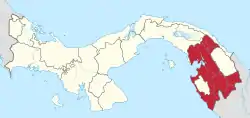Darién Gap
The Darién Gap (UK: /ˈdɛəriən, ˈdær-/,[1][2] US: /ˌdɛəriˈɛn, ˌdɑːr-, dɑːrˈjɛn/,[1][3][4] Spanish: Tapón del Darién [t̪a'põn ˈd̪el daˈɾjen], literally "Darién plug" [5]) is a break across the North and South American continents within Central America, consisting of a large watershed, forest, and mountains in the northern portion of Colombia's Chocó Department and Panama's Darién Province.
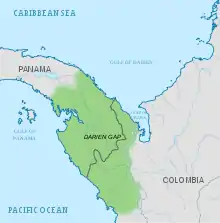
The Pan-American Highway also has a corresponding gap of 106 km (66 mi), beginning at Turbo, Colombia, and ending at Yaviza, Panama. Roadbuilding through this area is expensive and detrimental to the environment. Political consensus in favor of road construction collapsed after an initial attempt failed in the early 1970s, resuming in 1992 only to be halted by serious environmental concerns, and to date has not reemerged.
The geography of the Darién Gap on the Colombian side is dominated primarily by the river delta of the Atrato River, which creates a flat marshland at least 80 km (50 mi) wide. The Serranía del Baudó range extends along Colombia's Pacific coast and into Panama. The Panamanian side, in stark contrast, is a mountainous rainforest, with terrain reaching from 60 m (197 ft) in the valley floors to 1,845 m (6,053 ft) at the tallest peak (Cerro Tacarcuna, in the Serranía del Darién).
Pan-American Highway
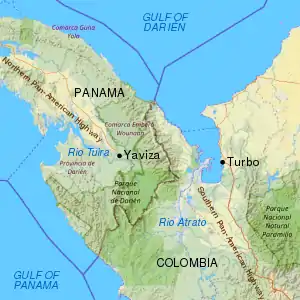
The Pan-American Highway is a system of roads measuring about 30,000 km (19,000 mi)[6] long that crosses through the entirety of North, Central, and South America, with the sole exception of the Darién Gap. On the South American side, the Highway terminates at Turbo, Colombia, near 8°6′N 76°40′W. On the Panamanian side, the road terminus is the town of Yaviza at 8°9′N 77°41′W. This marks a straight-line separation of about 100 km (60 mi). In between are marshland and forest.
Efforts have been made for decades to remedy this missing link in the Pan-American Highway. Planning began in 1971 with the help of American funding, but this was halted in 1974 after concerns were raised by environmentalists. Another effort to build the road began in 1992, but by 1994 a United Nations agency reported that the road, and the subsequent development, would cause extensive environmental damage. Cited reasons include evidence that the Darién Gap has prevented the spread of diseased cattle into Central and North America, which have not seen foot-and-mouth disease since 1954, and since at least the 1970s this has been a substantial factor in preventing a road link through the Darién Gap.[7][8] The Embera-Wounaan and Guna have also expressed concern that the road would bring about the potential erosion of their cultures.
Many people, groups, indigenous populations, and governments are opposed to completing the Darién portion of the highway. Reasons for opposition include protecting the rainforest, containing the spread of tropical diseases, protecting the livelihood of indigenous peoples in the area, preventing drug trafficking[9] and its associated violence, and preventing foot-and-mouth disease from entering North America. The extension of the highway as far as Yaviza resulted in severe deforestation alongside the highway route within a decade.
One option proposed, in a study by Bio-Pacifico, is a short ferry link from Colombia to a new ferry port in Panama, with an extension of the existing Panama highway that would complete the highway without violating these environmental concerns. Another idea is to use a combination of bridges and tunnels to avoid the environmentally sensitive regions.[10]
History
Pre-Columbian history

Archaeological knowledge of this area has received relatively little attention compared to its adjoining neighbors to the north and south, despite the fact that in the early 20th century, scholars such as Max Uhle, William Henry Holmes, C. V. Hartman, and George Grant MacCurdy undertook studies of archaeological sites and collections that were augmented by further research by Samuel Kirkland Lothrop, John Alden Mason, Doris Zemurray Stone, William Duncan Strong, Gordon Willey, and others. One of the reasons for the relative lack of attention is the lack of research by locals themselves in this regard. There is a large number of sites with impressive platform mounds, plazas, paved roads, stone sculpture, and artifacts made from jade, gold, and ceramic materials.
The Darién Gap is home to the Embera-Wounaan and Guna (as well as the Cueva before the 16th century). Travel is often conducted with specialized canoes ("piragua"). On the Panamanian side, La Palma, the area's cultural center, is the capital of the province. Other population centers include Yaviza and El Real. The Darién Gap had a reported population of 1,700 in 1980. Maize, cassava, plantains, and bananas are staple crops on local farms.
The Guna people lived in what is now Northern Colombia and the Darién Province of Panama at the time of the Spanish conquest, and subsequently began to move westward due to a conflict with the Spanish and other indigenous groups. Centuries before the conquest, the Gunas arrived in South America as part of a Chibchan migration moving east from Central America. At the time of the Spanish invasion, they were living in the region of Uraba near the borders of what are now Antioquia and Caldas. The Guna themselves attribute their migrations to conflicts with other chiefdoms, and their migration to nearby islands to mosquito populations on the mainland.
European settlement
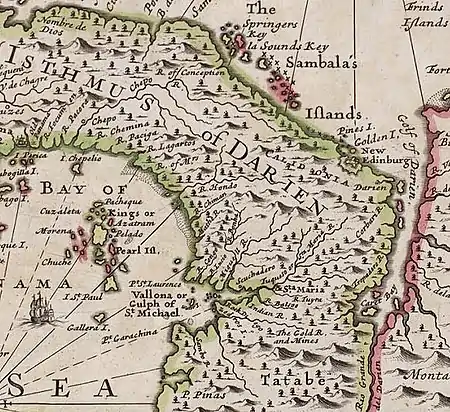
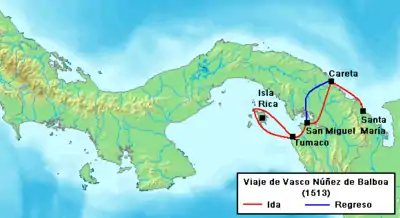
Vasco Núñez de Balboa and Alonso de Ojeda explored the coast of Colombia in 1500 and 1501. They spent the most time in the Gulf of Urabá, where they made contact with the Gunas. The regional border was initially created in 1508 after royal decree, to separate the colonial governorships of Castilla de Oro and Nueva Andalucía, using the River Atrato as the boundary between the two governorships.[11][12]
Balboa heard of the "South Sea" from locals while sailing along the Caribbean coast. On 25 September 1513, he saw the Pacific.
In 1519, the town of Panamá was founded near a small indigenous settlement on the Pacific coast. After the discovery of Peru, it subsequently developed into an important transshipment port as well as an administrative center.
In 1671, the Welsh pirate Henry Morgan crossed the Isthmus of Panamá from the Caribbean side and destroyed the city; the town was subsequently relocated a few kilometers to the west on a small peninsula. The ruins of the old town, Panamá Viejo, are preserved and were declared a UNESCO World Heritage Site in 1997.
Silver and gold from the viceroyalty of Peru were transported overland across the isthmus by Spanish Silver Train to Porto Bello, where Spanish treasure fleets shipped them to Seville and Cádiz from 1707. Lionel Wafer spent four years between 1680 and 1684 among the Gunas.
In 1698, Scotland tried to establish a settlement through the Darien scheme as part of its sole major attempt at colonialism. The first expedition of five ships (Saint Andrew, Caledonia, Unicorn, Dolphin, and Endeavor) set sail from Leith on 14 July 1698, with around 1,200 people on board.[13] Their orders were "to proceed to the Bay of Darien, and make the Isle called the Golden Island ... some few leagues to the leeward of the mouth of the great River of Darien ... and there make a settlement on the mainland".[14] After calling at Madeira and the West Indies, the fleet made landfall off the coast of Darien on November 2. The settlers christened their new home "New Caledonia".[15]
The aim was for the colony to have an overland route that connected the Pacific and Atlantic oceans. Since its inception, claims have been made that the undertaking was beset by poor planning and provisioning, divided leadership, a poor choice of trade goods, devastating epidemics of disease, reported attempts by the East India Company to frustrate it, as well as a failure to anticipate the Spanish Empire's military response. It was finally abandoned in March 1700 after a siege by Spanish forces, which also blockaded the harbor.
As the Company of Scotland was backed by approximately 20% of all the money circulating in Scotland, its failure left the Scottish Lowlands in substantial financial ruin; in fact, English financial incentives were a factor in persuading those in power to support the 1707 Acts of Union.[16] According to this argument, the Scottish establishment (landed aristocracy and mercantile elites) considered that their best chance of being part of a major power would be to share the benefits of England's international trade and the growth of the English overseas possessions, so its future would have to lie in unity with England. Furthermore, Scotland's nobles were almost bankrupted by the Darien fiasco.
The current border is regulated by the Victoria-Velez Treaty signed in Bogotá on 20 August 1924 by the Foreign Ministers of Panama, Nicolas Victoria; and Colombia, Jorge Velez. This treaty is officially registered in the Register No. 814 of the Treaty League of Nations, on 17 August 1925; said border was based on the same Colombian law of 9 June 1855.[17]
Natural resources
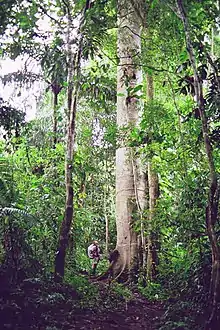
Two major national parks exist in the Darién Gap: Darién National Park in Panama and Los Katíos National Park in Colombia. The Darién Gap forests had extensive cedrela and mahogany cover until many of these trees were removed by loggers.
Darién National Park, the largest national park in Central America, covers roughly 5,790 km2 (579,000 ha; 2,240 sq mi; 1,430,000 acres) of land, and was established in 1980.
Copa Airlines Flight 201
On 6 June 1992, Copa Airlines Flight 201, a Boeing 737 jet airplane covering a flight between Panama City and Cali, Colombia, crashed in the Darién Gap, killing all 47 people on board.[18]
Crossings of the Darién Gap
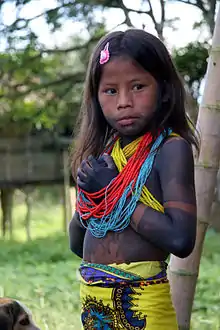
The Gap can be transited by off-road vehicles attempting intercontinental journeys. The first post-colonial expedition to the Darién was the Marsh Darien Expedition[19] in 1924–25, supported by several major sponsors, including the Smithsonian Institution.
The first vehicular crossing of the Gap was made by three Brazilians in two Ford Model Ts. They left Rio de Janeiro in 1928 and arrived in the United States in 1938. The expedition intended to claim attention for the Panamerican highway, after an International Conference in Chile, in 1923. The participants were Leonidas Borges de Oliveira, a lieutenant from Brazilian army, Francisco Lopez da Cruz from Brazilian air force, and Mário Fava, a young mechanic. They took what appears to be the last photo of Augusto Sandino, who received them in Nicaragua, and was received by Henry Ford and Franklin Roosevelt in the United States. Their story is available with photos from the book O Brasil através das três Américas written by Beto Braga. Another crossing was completed by the Land Rover La Cucaracha Cariñosa (The Affectionate Cockroach) and a Jeep of the Trans-Darién Expedition of 1959–60, crewed by Amado Araúz (Panama), his wife Reina Torres de Araúz, former Special Air Service man Richard E. Bevir (UK), and engineer Terence John Whitfield (Australia).[20] They left Chepo, Panama, on 2 February 1960 and reached Quibdó, Colombia, on 17 June 1960, averaging 201 m (220 yd) per hour over 136 days. They traveled a great deal of the distance up the vast Atrato River.

In December 1960, on a motorcycle trip from Alaska to Argentina, adventurer Danny Liska[21] attempted to transit the Darién Gap from Panama to Colombia.[22] Liska was forced to abandon his motorcycle and proceed across the Gap by boat and foot. In 1961, a team of three 1961 Chevrolet Corvairs and several support vehicles departed from Panama. The group was sponsored by Dick Doane Chevrolet (a Chicago Chevrolet dealer) and the Chevrolet division of General Motors. After 109 days they reached the Colombia Border with two Corvairs, the third having been abandoned in the jungle. It has been documented by a Jam Handy Productions film along with an article in Automobile Quarterly magazine (Volume 1 number 3, from the fall of 1962).
A pair of Range Rovers was used on the British Trans-Americas Expedition in 1972 led by John Blashford-Snell, which is claimed to be the first vehicle-based expedition to traverse both American continents north to south through the Darién Gap. The Expedition crossed the Atrato Swamp in Colombia with the cars on special inflatable rafts that were carried in the backs of the vehicles. However, they received substantial support from the British Army. Blashford-Snell's book, Something Lost Behind the Ranges (Harper Collins) has several chapters on the Darién expedition. The Hundred Days of Darien, a book written by Russell Braddon in 1974, also chronicles this expedition. In addition to the book, a video exists that was filmed by two Vancouver, BC based cameramen, Alan Bibby and Eric Rankin. These cameramen were mentioned in the book several times and can be seen in some of the still photos in the book.[23]
The first fully overland wheeled crossing (others used boats for some sections) of the Gap was that of British cyclist Ian Hibell, who rode from Cape Horn to Alaska between 1971 and 1973. Hibell took the "direct" overland south-to-north route, including an overland crossing of the Atrato Swamp in Colombia. Hibell completed his crossing of the Gap accompanied by two New Zealand cycling companions who had ridden with him from Cape Horn, but neither of these continued with Hibell on to Alaska.[24]
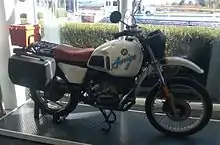
The first motorcycle crossing was by Robert L. Webb in March 1975. Another four-wheel drive crossing was in 1978–1979 by Mark A. Smith and his team. They drove the 400 km (250 mi) stretch of the gap in 30 days using five stock Jeep CJ-7s, traveling many kilometres up the Atrato River on barges.[25]
The first all-land auto crossing was in 1985–87 by Loren Upton and Patty Mercier in a CJ-5 Jeep, taking 741 days to travel 200 kilometres (125 miles). This crossing is documented in the 1992 Guinness Book of Records. Ed Culberson was the first one to follow the entire Pan-American highway including the Darién Gap proposed route on a motorcycle, a BMW R80G/S. From Yaviza, he first followed the Loren Upton team but would go solo just before Pucuru, hiring his own guides.[26]
In the 1990s, the gap was briefly joined by ferry service, provided by Crucero Express, until it ceased operations in 1997.
A number of notable crossings have been made on foot. Sebastian Snow crossed the Gap with Wade Davis in 1975 as part of his unbroken walk from Tierra del Fuego to Costa Rica. The trip is documented in his 1976 book The Rucksack Man and in Wade Davis's 1985 book The Serpent and the Rainbow. In 1981, George Meegan crossed the gap on a similar journey. He too started in Tierra del Fuego and eventually ended in Alaska. His 1988 biography, The Longest Walk, describes the trip and includes a 25-page chapter on his foray through the Gap. In 2001, as a part of his Goliath Expedition—a trek to forge an unbroken footpath from the tip of South America to the Bering Strait and back to his home in England—Karl Bushby (UK) crossed the gap on foot, using no transport or boats, from Colombia to Panama.
In July 1996, as part of their hitchhiking trip to Ushuaia through 17 Latin American countries, Walter Bläs, Ana Cravioto, Albrecht von der Recke and Gustavo Ross crossed from Panama to Colombia, becoming the first Mexicans to cross the Gap on foot, according to the visitors log kept since 1946 in Púcuro. The night of 28 July they survived the Hurricane Cesar–Douglas in the jungle somewhere between Paya and Palo de las Letras. Accompanied by 11 and 13-year-old Lico and Juan from Paya, the survivors reported several big trees falling around them and river levels rising up to 3 meters (10 feet) that night.
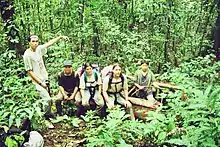
In 1979, evangelist Arthur Blessitt traversed the gap while carrying a 12-foot wooden cross, a trek confirmed by Guinness World Records as part of "the longest round the world pilgrimage" for Christ. Traveling alone with a machete plus one backpack crammed with water bottles, a hammock, Bible, notepad, lemon drops, and Blessitt's signature Jesus stickers saying "Smile! God Loves you", Blessitt describes his experience in a book, The Cross, and in an eponymous full-length movie.[27][28][29][30]
Most crossings of the Darién Gap region have been from Panama to Colombia. In July 1961, three college students, Carl Adler, James Wirth, and Joseph Bellina, crossed from the Bay of San Miguel to Puerto Obaldia on the Gulf of Parita (near Colombia) and ultimately to Mulatupu in what was then known as San Blas and now identified as Kuna Yala. The trip across the Darién was by banana boat, piragua, and foot via the Tuira river (La Palma and El Real de Santa Maria), Río Chucunaque (Yaviza), Rio Tuquesa (Chaua's (General Choco Chief) Trading Post—Choco Indian village) and Serranía del Darién.[31][32]
In 1985, Project Raleigh, which evolved from Project Drake in 1984 and in 1989 became Raleigh International, sponsored an expedition which also crossed the Darién coast to coast.[33] Their path was similar to the 1961 route above, but in reverse. The expedition started in the Bay of Caledonia at the Serranía del Darién, following the Río Membrillo ultimately to the Río Chucunaque and Yaviza, roughly following the route taken by Balboa in 1513.
Between the early 1980s and mid-1990s, Encounter Overland, a British adventure travel company, organized 2–3 week trekking trips through the Darién Gap from Panama to Colombia or vice versa. These trips used a combination of whatever transport was available: jeeps, bus, boats, and plenty of walking, with travelers carrying their own supplies. These groups were made up of male and female participants from any number of nationalities and age groups, and were led by experienced trek leaders. One leader went on to do nine Darién Gap trips and later acted as a logistics guide and coordinator for the BBC Natural History Unit during the production of a documentary called A Tramp in the Darien, which screened on BBC in 1990–91.
A complete overland crossing of the Darién rainforest on foot and riverboat (i.e., from the last road in Panama to the first road in Colombia) became more dangerous in the 1990s because of the Colombian conflict. The Colombian portion of the Darién rainforest in the Katios Park region eventually fell under control of armed groups. Furthermore, combatants from Colombia even entered Panama, occupied some Panamanian jungle villages and kidnapped or killed inhabitants and travelers. Just as hostilities were starting to worsen, 18-year-old Andrew Egan traversed the Darién Rainforest, detailing the excursion in the book Crossing the Darien Gap.
As of 2013, the coastal route on the east side of the Darién Isthmus has become relatively safe. This is by motorboat across the Gulf of Uraba from Turbo to Capurganá, and then hopping the coast to Sapzurro and hike from there to La Miel, Panama. Any inland routes through the Darién remain highly dangerous.[34] In June 2017, CBS journalist Adam Yamaguchi filmed smugglers leading refugees on a nine-day journey from Colombia to Panama through the Darién.[35]
Migrants from Africa, South Asia, the Middle East, and the Caribbean have been known to cross the Darién Gap as a method of migrating to the United States. This route may entail flying to Ecuador (taking advantage of that nation's liberal visa policy), and attempting to cross the gap on foot.[36] The journalist Jason Motlagh was interviewed by Sacha Pfeiffer on NPR's nationally syndicated radio show On Point in 2016 concerning his work following migrants through the Darién Gap.[37] Journalists Nadja Drost and Bruno Federico were interviewed by Nick Schifrin about their work following migrants through the Darién Gap in mid-2019 and the effects of the COVID-19 pandemic a year later, as part of a series on migration to the United States for the PBS NewsHour.[38][39][40]
Armed conflict
The Darién Gap was subject to the Marxist Revolutionary Armed Forces of Colombia (FARC), which has undergone an insurgency against the Colombian government.[41] FARC rebels were present on both the Colombian and Panamanian sides of the border.[42]
In 2000, two British travelers, Tom Hart Dyke and Paul Winder, were kidnapped by FARC in the Darién Gap while hunting for exotic orchids, plants for which Dyke has a particular passion. The two were held captive for nine months and threatened with death before eventually being released unharmed and without a ransom being paid. Dyke and Winder later documented their experience in the book The Cloud Garden and in an episode of Locked Up Abroad.
Other political victims include three New Tribes missionaries, who disappeared from the Panamanian side in 1993.[43]
In 2003, Robert Young Pelton, on assignment for National Geographic Adventure magazine, and two traveling companions, Mark Wedeven and Megan Smaker, were detained for one week by the United Self-Defense Forces of Colombia, a far-right paramilitary organization, in a highly publicized incident.[44][45]
In May 2013, Swedish backpacker Jan Philip Braunisch disappeared in the area after leaving the Colombian town of Riosucio with the intention of attempting a crossing on foot to Panama, via the Cuenca Cacarica. The FARC admitted to killing him, having mistaken him for a foreign spy.[46]
See also
References
- "Darien". Collins English Dictionary. HarperCollins. Retrieved 23 July 2019.
- "Darien". Lexico UK Dictionary. Oxford University Press. Retrieved 23 July 2019.
- "Darién". The American Heritage Dictionary of the English Language (5th ed.). Boston: Houghton Mifflin Harcourt. Retrieved 23 July 2019.
- "Darién". Merriam-Webster Dictionary. Retrieved 23 July 2019.
- "El infierno de cruzar el Tapón del Darién, la región más intransitable y peligrosa de América Latina (que corta en dos la ruta Panamericana)". January 31, 2018 – via www.bbc.com.
- "A Gap in the Andes : Image of the Day". NASA. Retrieved 2017-09-17.
- "Construction Progress and Problems of the Darien Gap Highway" (PSAD-77-154). Government Accountability Office. 1977-08-15. Cite journal requires
|journal=(help) - "Press Releases 2011". Embassy of the United States to Panama. Archived from the original on 2012-04-24. Retrieved 2017-01-10.
- Perilla, Jisel (4 January 2011). Frommer's Panama. John Wiley & Sons. p. 239. ISBN 978-1-118-00112-7.
- http://www.futuristspeaker.com/2014/12/the-coming-era-of-mega-systems-part-1-transportation/ The Coming Era of Mega Systems, Part 1 – Transportation
- Berrio-Lemm, Vladimir. A short survey of public international law: Limits of Costa Rica and Panama. Page 47. Lottery # 420 Cultural Magazine. September–October 1998
- Andagoya, Pascual de (21 June 1865). Narrative of the Proceedings of Pedrarias Davila. The Hakluyt Society. Retrieved 2019-06-21 – via Wikisource.
- McClymont, Roy. "The Darien Scheme: A Supplement". Appalachian State University, History Department. Retrieved 2015-11-14.
- Pratt Insh, George (1924). Papers Relating to the Ships and Voyages of the Company of Scotland Trading to Africa and the Indies, 1696–1707 (PDF). Edinburgh: Scottish History Society. pp. 64–65.
- Hidalgo, Dennis R. (2001). "To Get Rich for Our Homeland: The Company of Scotland and the Colonization of the Darién". CLAHR: Colonial Latin American Historical Review. 10 (3): 311–350.
- Brocklehurst, "The Banker who Led Scotland to Disaster".
- De Leon, Raquel Maria. Boundaries and Borders'. Panama. 1965.
- "El misterioso vuelo 201 de Copa que se desintegró en Darién". El Siglo.
- "Error 404: Page Not Found". www.nmnh.si.edu. Archived from the original on 2014-04-21. Retrieved 2017-01-10. Cite uses generic title (help)
- "Trans Darien Expedition". 2009-10-27. Archived from the original on 2009-10-27. Retrieved 2017-01-10.
- Danny Liska Archived September 30, 2007, at the Wayback Machine
- Danny Liska "Across the Darien Gap by River and Trail II", Peruvian Times, Vol XXI, Num. 1068(June 2, 1961), pg. 10
- This video is available online as Darien Conquest, presented by Forces Network.
- Hibell's "Cape Horn to Alaska" expedition forms part of his 1984 book Into the Remote Places.
- Smith has since released his book, Driven by a Dream, which documents the crossing.
- Obsessions Die Hard
- "Guinness World Records". www.guinnessworldrecords.com. Archived from the original on 2013-01-25. Retrieved 2017-01-10.
- Blessitt, Arthur (2008-01-01). The Cross. Trinity Broadcasting Network.
- "The Cross". www.thecrossfilm.com. Archived from the original on 2009-03-16. Retrieved 2017-01-10.
- "The Official Website of Arthur Blessitt". The Official Website of Arthur Blessitt. Retrieved 2017-01-10.
- "Brought Back Darien Bush", Panama Star & Herald], July 9, 1961, pg. 1
- Carl Adler, "A Trip to Panama", The Scholastic, Vol. 104, No. 11, January 18, 1963, pg. 18
- "After Trek Through the Jungle Youth's Ready to Go Again". Raleigh The News & Observer, June 25, 1985
- Crossing the Darien Gap, documentary film (2013, 2016), March 2013.
- "The Darien Gap — A Desperate Journey". Retrieved 2017-10-10.
- Kahn, Carrie (22 June 2016). "ia Cargo Ships and Jungle Treks, Africans Dream Of Reaching The U.S. 5:02 Queue Download Embed Transcript Facebook Twitter Google+ Email June 22, 20165:27 PM ET". NPR. Retrieved 2016-06-23.
- "Stories From The Dangerous Darién Gap | On Point". WBUR. Retrieved 2016-08-08.
- Drost, Nadja; Federico, Bruno (11 January 2020). "Yielding to U.S. pressure, Mexico clamps down on migrants". PBS NewsHour. PBS. Retrieved 13 August 2020.
- Drost, Nadja; Federico, Bruno (12 August 2020). "What migrants face as they journey through the deadly Darien Gap". PBS NewsHour. PBS. Retrieved 13 August 2020.
- Drost, Nadja; Federico, Bruno; Schifrin, Nick (13 August 2020). "How U.S. immigration policy affects fate of migrants braving the deadly Darien Gap". PBS NewsHour. PBS. Retrieved 14 August 2020.
- Refugees, United Nations High Commissioner for. "Refworld | Amnesty International Report 2005 - Colombia". Refworld. Retrieved 2017-01-10.
- "Panama's Darien teems with FARC drug runners". Reuters. 26 May 2010.
- Alford, Deann (1 September 2001). "New Tribes Missionaries Kidnapped in 1993 Declared Dead". Christianity Today. Retrieved 2011-09-27.
- "3 Americans freed, 2 journalists still captive in Colombia". CNN.com. 2003-01-24. Retrieved 2007-05-22.
- Markey, Sean (2003-01-22). "Adventure Writer Reportedly Kidnapped in Panama". National Geographic News. Retrieved 2007-05-15.
- "FARC admits to killing Swedish tourist in northwest Colombia". ColombiaReports.com. Retrieved 2015-10-06.
External links
| Wikivoyage has a travel guide for Darien Gap. |
